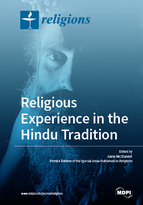Religious Experience in the Hindu Tradition
A special issue of Religions (ISSN 2077-1444).
Deadline for manuscript submissions: closed (1 January 2019) | Viewed by 102688
Special Issue Editor
Interests: history of religions; mysticism; Hinduism; Bengali Shaktism; Tantra; Bhakti; yoga; folklore; gender and women’s studies; ritual studies; anthropology of religion
Special Issues, Collections and Topics in MDPI journals
Special Issue Information
This issue would explore religious experience in a variety of Hindu traditions, including Vedanta, Yoga, Sant Mat, Nirguna bhakti, Vaishnavism, Shaktism, Shaivism, Tantra and Folk Religion. There have been books that focused on specific regional and textual forms of Hinduism, but we have not had any books that cover the wide range of religious experiences in Hindu religion and the ways that they are understood. This can give scholars and students an idea of how Hinduism is a living tradition, and describe the ways that Hindu religious ideas impact the lives of modern practitioners.
Dear Colleagues,
The focus of this issue is religious experience in Hinduism. This religion has some of the most vivid and varied forms of mystical, yogic and devotional experiences that can be found in world religions, but they have never been organized into a single volume that includes living practitioners.
Its scope would be the various forms of Hinduism in India, and would include both modern and historical data.
Its purpose is to enrich scholarly understanding of an important aspect of life in India, including not just official beliefs in Hinduism, but also the experiences of its practitioners. It could mix together ancient and modern religious worlds, and include anthropological data as well and philosophical and theological ideas.
There is currently no literature that studies comparative forms of religious experience in India. Most books that address the topic of religious experience are historical and literary, examining data from saint biographies, statements by sectarian authorities, and the development of devotional movements in specific regions of India. In this issue, we add to this by including the experiences of living practitioners in a variety of Hindu traditions. This can show the ways that religions unite ideas from past and present, and the ways that religion plays a part in the lived experience of believers.
Prof. Dr. June McDaniel
Guest Editor
Manuscript Submission Information
Manuscripts should be submitted online at www.mdpi.com by registering and logging in to this website. Once you are registered, click here to go to the submission form. Manuscripts can be submitted until the deadline. All submissions that pass pre-check are peer-reviewed. Accepted papers will be published continuously in the journal (as soon as accepted) and will be listed together on the special issue website. Research articles, review articles as well as short communications are invited. For planned papers, a title and short abstract (about 100 words) can be sent to the Editorial Office for announcement on this website.
Submitted manuscripts should not have been published previously, nor be under consideration for publication elsewhere (except conference proceedings papers). All manuscripts are thoroughly refereed through a double-blind peer-review process. A guide for authors and other relevant information for submission of manuscripts is available on the Instructions for Authors page. Religions is an international peer-reviewed open access monthly journal published by MDPI.
Please visit the Instructions for Authors page before submitting a manuscript. The Article Processing Charge (APC) for publication in this open access journal is 1800 CHF (Swiss Francs). Submitted papers should be well formatted and use good English. Authors may use MDPI's English editing service prior to publication or during author revisions.
Keywords
- Hinduism
- India
- religious experience
- bhava
- mahabhava
- possession trance
- spiritual song
- visualization
- meditation
- contemplation
- deities
- sacred sound
- divine love
- revelation
- worship
- inspiration






